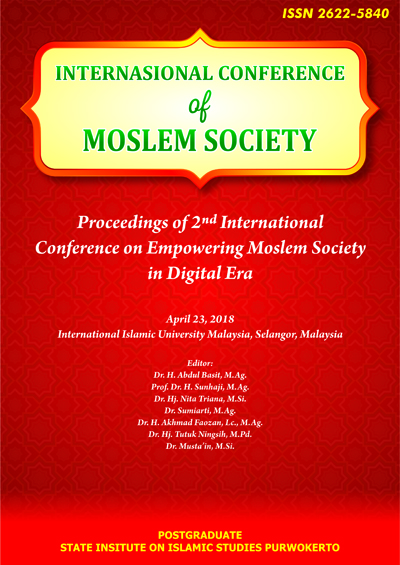The Role of Teachers in Teaching Sexual Education for Primary School Students
DOI:
https://doi.org/10.24090/icms.2018.3284Keywords:
teacher, sexual education, primary schoolAbstract
Teachers in primary school have role as second parents at school by teaching and guiding students to prepare them for real life in the community. Primary school students, in the age range 6-12 years, are prepared for further development in adolescence or puberty. At that age, both male and female students are exposed to various sexual problems. Therefore, it is important to provide sexual education for primary school students. Unfortunately, schools only teach the function of reproductive organs. Teachers do not explain the dangers of sexual deviance and important values ​​of sexual education. Often teachers are very awkward when they teach something related to sex. It makes children curious and will find out more about sex by themselves. They look for it on the internet where there are a lot of inappropriate content for primary school students. The lack of sex education needs to be improved so that cases of adolescents who have premarital sex, people who are pregnant out of wedlock and other sexual deviations may be reduced in the future. Therefore, teachers are expected to play a big role in accompanying the growth and sexual development of students. This paper contains thoughts and ideas of the author in maximizing the role of teachers in teaching sexual education for primary school students.Downloads
Download data is not yet available.
References
Amin, K. M. (1997). Kiat Selamatkan Cinta. Yogyakarta: Titian Ilahi Press.
Arikunto, S. (1998). Prosedur Penelitian. Jakarta: PT. Rineka Cipta.
Hadi, S. (1991). Metodologi Research. Yogyakarta: Andi Offset.
Madani, Y. (2003). Pendidikan Seks untuk Anak dalam Islam: Panduan bagi Orang Tua, Guru, Ulama, dan Kalangan Lainnya. Jakarta: Pustaka Zahra.
Memberikan Pendidikan Seks yang Sesuai dengan Umur Anak. (2018, March 30). Retrieved from RuangPsikologi.com: http://ruangpsikologi.com
Roqib, M. (2008). Pendidikan Seks pada Anak Usia Dini. Jurnal Pemikiran Alternatif Pendidikan. Vol. 13 No. 2 (2008), 271-286.
Singarimbun, M. (1989). Metode Penelitian Survey. Jakarta: LP3ES.
Sukardi. (2009). Metodologi Penelitian Pendidikan. Jakarta: PT. Bumi Aksara.
Suraji. (2008). Pendidikan Seks bagi Anak. Yogyakarta: Pustaka Fahima.
Syamsudin. (1985). Pendidikan Kelamin dalam Islam. Solo: Ramadhani.
Ulwan, N. (1996). Pendidikan Seks. Bandung: Remaja Rosda Karya.
Arikunto, S. (1998). Prosedur Penelitian. Jakarta: PT. Rineka Cipta.
Hadi, S. (1991). Metodologi Research. Yogyakarta: Andi Offset.
Madani, Y. (2003). Pendidikan Seks untuk Anak dalam Islam: Panduan bagi Orang Tua, Guru, Ulama, dan Kalangan Lainnya. Jakarta: Pustaka Zahra.
Memberikan Pendidikan Seks yang Sesuai dengan Umur Anak. (2018, March 30). Retrieved from RuangPsikologi.com: http://ruangpsikologi.com
Roqib, M. (2008). Pendidikan Seks pada Anak Usia Dini. Jurnal Pemikiran Alternatif Pendidikan. Vol. 13 No. 2 (2008), 271-286.
Singarimbun, M. (1989). Metode Penelitian Survey. Jakarta: LP3ES.
Sukardi. (2009). Metodologi Penelitian Pendidikan. Jakarta: PT. Bumi Aksara.
Suraji. (2008). Pendidikan Seks bagi Anak. Yogyakarta: Pustaka Fahima.
Syamsudin. (1985). Pendidikan Kelamin dalam Islam. Solo: Ramadhani.
Ulwan, N. (1996). Pendidikan Seks. Bandung: Remaja Rosda Karya.
Downloads
Published
2018-04-23
How to Cite
Supriyati, S. (2018). The Role of Teachers in Teaching Sexual Education for Primary School Students. International Conference of Moslem Society, 2, 301–306. https://doi.org/10.24090/icms.2018.3284
Issue
Section
ICMS 2018
License
Authors who publish with this journal agree to the following terms:
- Authors retain copyright and grant the journal right of first publication with the work simultaneously licensed under a Creative Commons Attribution-ShareAlike 4.0 License that allows others to share the work with an acknowledgement of the work's authorship and initial publication in this journal.
- Authors are able to enter into separate, additional contractual arrangements for the non-exclusive distribution of the journal's published version of the work (e.g., post it to an institutional repository or publish it in a book), with an acknowledgement of its initial publication in this journal.
- Authors are permitted and encouraged to post their work online (e.g., in institutional repositories or on their website) prior to and during the submission process, as it can lead to productive exchanges, as well as earlier and greater citation of published work (See The Effect of Open Access).


